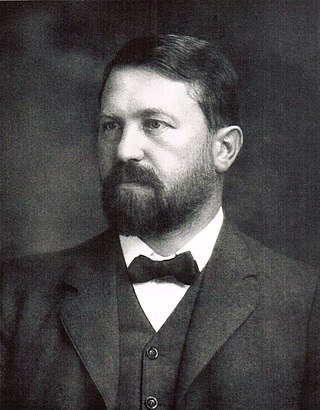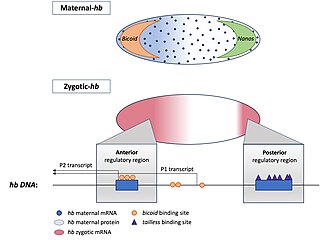Related Research Articles

Gastrulation is the stage in the early embryonic development of most animals, during which the blastula, or in mammals the blastocyst, is reorganized into a two-layered or three-layered embryo known as the gastrula. Before gastrulation, the embryo is a continuous epithelial sheet of cells; by the end of gastrulation, the embryo has begun differentiation to establish distinct cell lineages, set up the basic axes of the body, and internalized one or more cell types including the prospective gut.

Howard Robert Horvitz ForMemRS NAS AAA&S APS NAM is an American biologist best known for his research on the nematode worm Caenorhabditis elegans, for which he was awarded the 2002 Nobel Prize in Physiology or Medicine, together with Sydney Brenner and John E. Sulston, whose "seminal discoveries concerning the genetic regulation of organ development and programmed cell death" were "important for medical research and have shed new light on the pathogenesis of many diseases".

The blastocoel, also spelled blastocoele and blastocele, and also called cleavage cavity, or segmentation cavity is a fluid-filled or yolk-filled cavity that forms in the blastula during very early embryonic development. At this stage in mammals the blastula develops into the blastocyst containing an inner cell mass, and outer trophectoderm.

Theodor Heinrich Boveri was a German zoologist, comparative anatomist and co-founder of modern cytology. He was notable for the first hypothesis regarding cellular processes that cause cancer, and for describing chromatin diminution in nematodes. His brother was industrialist Walter Boveri. Boveri was married to the American biologist Marcella O'Grady (1863–1950). Their daughter Margret Boveri (1900–1975) became one of the best-known journalists in post-World War II Germany.
Trudi Schüpbach is a Swiss-American molecular biologist. She is an Emeritus Professor of Molecular Biology at Princeton University, where her laboratory studies molecular and genetic mechanisms in fruit fly oogenesis.
Hyalin is a protein released from the cortical granules of a fertilized animal egg. The released hyalin modifies the extracellular matrix of the fertilized egg to block other sperm from binding to the egg, and is known as the slow-block to polyspermy. All animals have this slow-block mechanism.
Within the field of developmental biology, one goal is to understand how a particular cell develops into a final cell type, known as fate determination. Within an embryo, several processes play out at the cellular and tissue level to create an organism. These processes include cell proliferation, differentiation, cellular movement and programmed cell death. Each cell in an embryo receives molecular signals from neighboring cells in the form of proteins, RNAs and even surface interactions. Almost all animals undergo a similar sequence of events during very early development, a conserved process known as embryogenesis. During embryogenesis, cells exist in three germ layers, and undergo gastrulation. While embryogenesis has been studied for more than a century, it was only recently that scientists discovered that a basic set of the same proteins and mRNAs are involved in embryogenesis. Evolutionary conservation is one of the reasons that model systems such as the fly, the mouse, and other organisms are used as models to study embryogenesis and developmental biology. Studying model organisms provides information relevant to other animals, including humans. While studying the different model systems, cells fate was discovered to be determined via multiple ways, two of which are by the combination of transcription factors the cells have and by the cell-cell interaction. Cells' fate determination mechanisms were categorized into three different types, autonomously specified cells, conditionally specified cells, or syncytial specified cells. Furthermore, the cells' fate was determined mainly using two types of experiments, cell ablation and transplantation. The results obtained from these experiments, helped in identifying the fate of the examined cells.

Fate mapping is a method used in developmental biology to study the embryonic origin of various adult tissues and structures. The "fate" of each cell or group of cells is mapped onto the embryo, showing which parts of the embryo will develop into which tissue. When carried out at single-cell resolution, this process is called cell lineage tracing. It is also used to trace the development of tumors.
In early Drosophila development, the first 13 cells pass through mitosis are nuclear divisions (karyokinesis) without cytokinesis, resulting in a multinucleate cell. Pole cells are the cells that form at the polar ends of the Drosophila egg, which begin the adult germ cells. Pole plasm functions to bud the development of pole cells, as well as restore fertilization, even when the cell was previously sterile.
Skeletogenesis is a key morphogenetic event in the embryonic development of vertebrates and is of equal, although transient, importance in the development of the sea urchin, a marine invertebrate. The larval sea urchin does not resemble its adult form, because the sea urchin is an indirect developer, meaning its larva form must undergo metamorphosis to form the juvenile adult. Here, the focus is on skeletogenesis in the sea urchin species Strongylocentrotus purpuratus, as this species has been most thoroughly studied and characterized.
Norbert Perrimon is a French geneticist and developmental biologist. He is the James Stillman Professor of Developmental Biology in the Department of Genetics at Harvard Medical School, an Investigator at the Howard Hughes Medical Institute, and an Associate of the Broad Institute. He is known for developing a number of techniques for used in genetic research with Drosophila melanogaster, as well as specific substantive contributions to signal transduction, developmental biology and physiology.

Elizabeth Jane Robertson is a British developmental biologist based at the Sir William Dunn School of Pathology, University of Oxford. She is Professor of Developmental Biology at Oxford and a Wellcome Trust Principal Research Fellow. She is best known for her pioneering work in developmental genetics, showing that genetic mutations could be introduced into the mouse germ line by using genetically altered embryonic stem cells. This discovery opened up a major field of experimentation for biologists and clinicians.
Margaret Buckingham, is a British developmental biologist working in the fields of myogenesis and cardiogenesis. She is an honorary professor at the Pasteur Institute in Paris and emeritus director in the Centre national de la recherche scientifique (CNRS). She is a member of the European Molecular Biology Organization, the Academia Europaea and the French Academy of Sciences.
William R. Jeffery is an American professor of evolutionary developmental biology whose studies focus on the evolution of development, especially blind cavefish and tunicates. He is a fellow of the American Association for the Advancement of Science and the Linnean Society of London.

Richard Paul Harvey is a molecular biologist, the Sir Peter Finley professor of Heart Research at the University of New South Wales and Deputy Director and Head of the Developmental and Stem Cell Biology Division at the Victor Chang Cardiac Research Institute.
John Philip "Trink" Trinkaus was an American embryologist and one of the world's leading experts on in vivo cell motility.
Marie A. DiBerardino was an American biologist, specializing in developmental biology and genetics. She is known, with Robert William Briggs and Thomas Joseph King, as a pioneer in amphibian cloning.
Laurinda A. Jaffe is an American biologist who is a Professor and chair at the University of Connecticut. Her research considers the physiological mechanisms that regulate oocyte cell and fertilisation. She was elected to the National Academy of Sciences in 2021.
Linda Zimmerman Holland is a research biologist at Scripps Institution of Oceanography known for her work examining the evolution of vertebrates.

Hunchback is a maternal effect and zygotic gene expressed in the embryos of the fruit fly Drosophila melanogaster. In maternal effect genes, the RNA or protein from the mother’s gene is deposited into the oocyte or embryo before the embryo can express its own zygotic genes.
References
- ↑ "UMass Amherst: Biology Department: Alumni Links". www.bio.umass.edu. Retrieved 2021-12-25.
- 1 2 3 "Resolution on the Retirement of Susan Ernst, Department of Biology". 2021-12-16. Archived from the original on 16 December 2021. Retrieved 2021-12-25.
- ↑ Ernst, Susan G.; Hough-Evans, Barbara R.; Britten, Roy J.; Davidson, Eric H. (1980-09-01). "Limited complexity of the RNA in micromeres of sixteen-cell sea urchin embryos". Developmental Biology. 79 (1): 119–127. doi:10.1016/0012-1606(80)90077-9. ISSN 0012-1606. PMID 6157591.
- ↑ Nocente-McGrath, Catherine; Brenner, Carol A.; Ernst, Susan G. (1989-11-01). "Endo16, a lineage-specific protein of the sea urchin embryo, is first expressed just prior to gastrulation". Developmental Biology. 136 (1): 264–272. doi:10.1016/0012-1606(89)90147-4. ISSN 0012-1606. PMID 2680683.
- ↑ Levin, Michael; Ernst, Susan G. (1995). "Applied AC and DC magnetic fields cause alterations in the mitotic cycle of early sea urchin embryos". Bioelectromagnetics. 16 (4): 231–240. doi:10.1002/bem.2250160405. ISSN 1521-186X. PMID 7488256.
- ↑ Hutson, Matthew (2021-04-29). "Persuading the Body to Regenerate Its Limbs". The New Yorker. Retrieved 2021-12-25.
- ↑ "Historic Fellows | American Association for the Advancement of Science". www.aaas.org. Retrieved 2021-12-16.